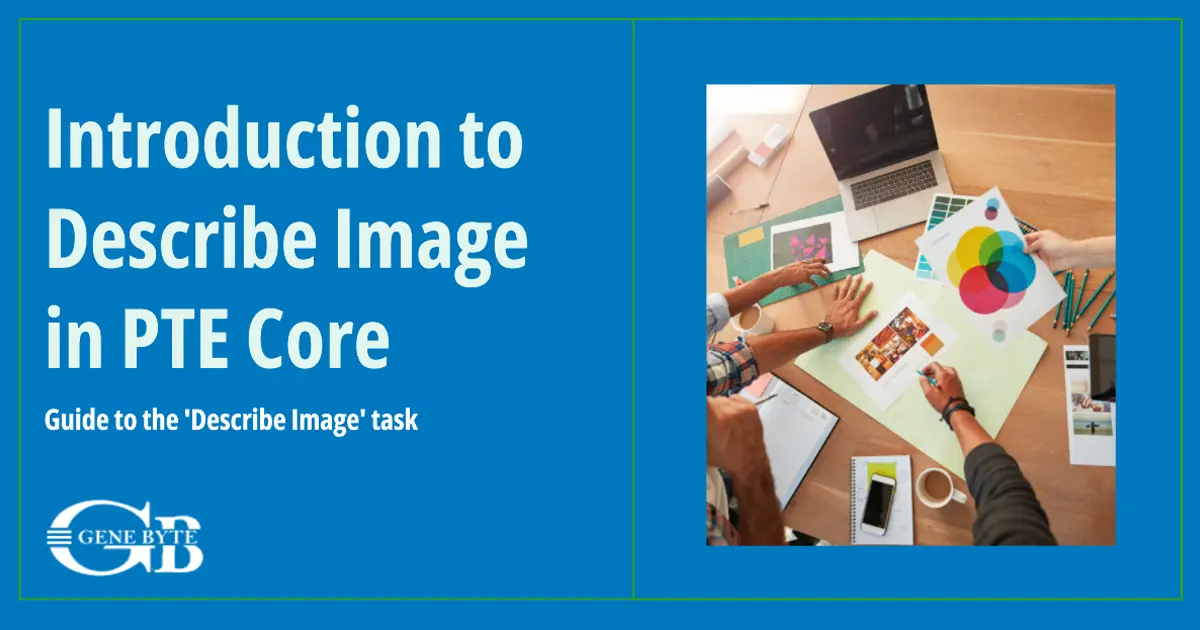PTE Core Insights:
Describe Image for Educators
A Teacher's Guide to PTE Core Describe Image

"Mastering the Describe Image task is not just about passing an exam; it's about equipping students with the skills necessary for effective communication in a global context."
In the Speaking Section of PTE Core, the Describe Image question-type stands as a beacon of analytical and expressive proficiency. Genebyte leverages cutting-edge AI to equip educators with the tools needed to decode and teach this challenging aspect.
This segment's objective is twofold: first, to demystify the complexities surrounding this task for educators, thereby enhancing their instructional methodologies. Second, it aims to foster a deeper understanding of how mastering this question-type can significantly impact students' overall performance in the PTE Core exam. By focusing on Describe Image, we not only refine students' linguistic precision but also their critical thinking, preparing them for diverse communicative challenges beyond the examination room.

Introduction to Describe Image in PTE Core
Overview of the PTE Core Exam
PTE Core, designed to assess the English language proficiency of speakers aiming for professional and migration opportunities, offers a comprehensive evaluation across speaking, writing, reading, and listening skills. Unlike its academic counterpart, PTE Core focuses on everyday English, making it relevant for a wide array of candidates.
Importance of Describe Image Question-Type
This task-type stands out as a unique blend of analytical and linguistic challenge, requiring test-takers to succinctly describe visual information. It not only tests one's ability to communicate effectively in English but also evaluates critical thinking and the capacity to convey complex ideas clearly.
How This Task Is Different from PTE Academic's
While both exams include image description tasks, PTE Core's version emphasizes everyday contexts, making it distinct from the academically inclined scenarios of PTE Academic. This shift highlights the importance of practical language use over academic language proficiency, aligning with the real-world communication needs of professionals and migrants.

Understanding the Describe Image Task
Task Description: Image Analysis and Description Process
The Describe Image task, following the Repeat Sentence task in the test, is a straightforward question type where candidates are required to observe a picture and articulate a coherent description within a limited timeframe. This task assesses the ability to quickly interpret visual data and express this understanding verbally, mirroring real-world scenarios where effective communication of visual information is crucial.
Prompt Length and Response Time
Candidates are presented with an image and have 25 seconds to prepare their response, following which they must deliver their description within 40 seconds. Starting the response within 3 seconds is essential to ensure the full utilization of allotted time.
Scoring Criteria: How Responses Are Evaluated
The evaluation of responses is multifaceted, focusing on:
- Fluency and Coherence: The smoothness of speech and logical flow of ideas.
- Lexical Resource: The range and accuracy of vocabulary used.
- Grammatical Range and Accuracy: The variety and correctness of grammatical structures.
- Pronunciation: The clarity and correctness of speech sounds.
| Criteria | Description |
|---|---|
| Fluency and Coherence | Ability to speak at a steady pace without undue hesitation and logically connect ideas. |
| Lexical Resource | Use of a wide range of vocabulary appropriately. |
| Grammatical Range and Accuracy | Correct use of sentence structures and grammatical forms. |
| Pronunciation | Clear and understandable articulation of words. |
The task's unique challenge lies in synthesizing and verbalizing a concise yet comprehensive analysis of the image, a skill that is invaluable not only for test success but also for effective communication in academic and professional contexts.

Teaching Describe Image
Incorporating Visual Analysis in Classroom Activities
Integrating visual analysis into the curriculum enriches the learning experience, enabling students to hone their observation and description skills. Through interactive sessions, educators can guide students in dissecting images, identifying key elements, and structuring their descriptions effectively. This hands-on approach fosters a deeper understanding of how to convey complex visual information succinctly.
Utilizing Templates: Pros and Cons
Templates can serve as a valuable tool for structuring responses, providing a framework that students can adapt to various images. However, reliance on templates may limit creativity and the ability to respond to unique aspects of each image. It's crucial to strike a balance, encouraging the use of templates for foundational structure while promoting flexibility and original thought.
Leveraging Prediction File in Teaching
The prediction file, a comprehensive resource detailing common themes and vocabulary associated with different image types, can significantly enhance teaching strategies. By familiarizing students with likely scenarios and specialized terminology, educators can equip them with the skills to approach the Describe Image task with confidence and precision.
- Strategies for Effective Teaching:
- Interactive Analysis Workshops
- Template Adaptation Sessions
- Prediction File Exercises

Technology in Teaching Describe Image
Genebyte's AI-Powered Solutions for Effective Learning
Genebyte introduces a revolutionary approach to mastering the Describe Image task with its AI-powered solutions. These tools are designed to simulate real exam conditions, providing instant feedback on fluency, vocabulary, grammatical structure, and pronunciation. By integrating these technologies into their teaching methodologies, educators can offer personalized learning experiences that target each student's specific weaknesses, significantly enhancing their ability to describe images with precision and confidence.
How AI Tools Can Enhance Understanding and Performance
The utilization of AI tools in preparation for the Describe Image task transforms the learning process. These technologies analyze students' responses for key elements such as content coverage, linguistic range, and delivery effectiveness. By doing so, they provide actionable insights that enable students to refine their skills iteratively.
- Benefits of AI in Learning:
- Personalized Feedback: Tailors advice to individual student needs, focusing on areas requiring improvement.
- Enhanced Engagement: Interactive exercises and real-time corrections keep students engaged and motivated.
- Efficiency in Learning: Accelerates the learning curve by identifying and addressing gaps in knowledge swiftly.
Genebyte's platform stands as a beacon for coaching institutes aiming to elevate their educational offerings. Through our sophisticated AI-driven analysis, we ensure that students are not only prepared to meet the challenges of the PTE Core's Describe Image task but are also equipped with the skills necessary for effective communication in diverse contexts. This aligns with our mission to harness technology in crafting solutions that not only prepare students for exams but also for real-world communication challenges, thereby redefining the landscape of language proficiency training.

Actionable Steps for PTE Core's Describe Image
In leveraging Genebyte's AI-powered solutions for PTE Core's Describe Image task, educators can significantly enhance the learning experience and outcomes for their students.
- Integrate AI Feedback: Use Genebyte's real-time feedback to focus on areas needing improvement, personalizing the learning journey for each student.
- Practice with Variety: Engage students with a wide range of images to build versatility in their descriptive skills.
- Encourage Critical Analysis: Foster an environment where students critically analyze images beyond the surface level, using Genebyte's insights to guide discussions.
Mastering the Describe Image task is crucial not just for PTE Core success but for nurturing comprehensive communication skills. Next, students advance to a new task-type, Respond to a Situation. Genebyte's technology offers a unique advantage, blending AI precision with educational expertise to elevate teaching methodologies and student achievements.
Elevate your institute's teaching capabilities with Genebyte's AI solutions. Discover how our platform can transform your approach to the Describe Image task and beyond. Engage with us today to redefine English language proficiency training.
Frequently Asked Questions
To effectively describe an image in the PTE Core, focus on a structured approach: start with a brief overview, discuss notable elements, and conclude with a summary or inference. Employ clear, concise language and prioritize key features of the image that are immediately striking or relevant to common themes.
The Describe Image task in PTE Core evaluates your ability to analyze and verbally articulate the content and context of a visual prompt. This task measures your speaking skills, including fluency, vocabulary, grammatical range, and pronunciation, within a specified timeframe.
The number of Describe Image tasks in the PTE Core exam can vary. For the most current and specific information, refer to the latest guidelines provided by PTE Core for the 2023 examination cycle.
Marking criteria for the Describe Image task include fluency, vocabulary, grammatical accuracy, and pronunciation. Each aspect is critically evaluated to determine the overall effectiveness of the image description.
An example approach involves systematically covering the image's foreground, background, key subjects, and any text or numbers present, followed by an interpretive summary of the scene or data.
- Practice with a variety of images.
- Use descriptive vocabulary.
- Structure your response clearly.
- Time your practice sessions.
- Observe the image carefully.
- Note key features or elements.
- Plan a structured response.
- Begin speaking promptly and clearly.
This task is crucial for assessing comprehensive speaking skills in a context that mimics real-world communication scenarios, emphasizing the practical application of English language proficiency.
While there's no strict word limit, your response is constrained by the 40-second time limit, encouraging concise and focused descriptions.